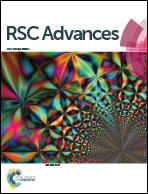A quinoline based Schiff-base compound as pH sensor†
Abstract
A new Schiff-base compound, 1,4-bis-(quinolin-6-ylimino methyl)benzene (BQB), has been synthesized by the reaction between terephthaldehyde and 6-aminoquinoline (1 : 2 ratio) and characterized by elemental analysis and different spectroscopic methods. The Schiff-base compound, designated as BQB, undergoes protonation in acidic medium and has been designated as PBQB. PBQB shows emission intensity at 550 nm at low pH and with the increase in pH, the intensity of the peak at 550 nm decreases with simultaneous shift of the emission band to 453 nm. The intensity of the peak at 453 nm increases as pH of the medium is raised and the phenomenon is found to be reversible. Reversibility of fluorescence intensity of BQB with pH shows that the system is stable in both basic and acidic media. Absorption spectrum of the compound shows band at 380 nm with a strong shoulder at 402 nm in low pH which changes to 344 nm at higher pH region. Naked eye detection of colour change at different pH regions is possible using the probe. Position of absorption band of BQB is changed in acidic medium due to protonation of the ring nitrogen atom present in it as reflected by theoretical studies. We have applied our probe to detect the pH region of river water.


 Please wait while we load your content...
Please wait while we load your content...